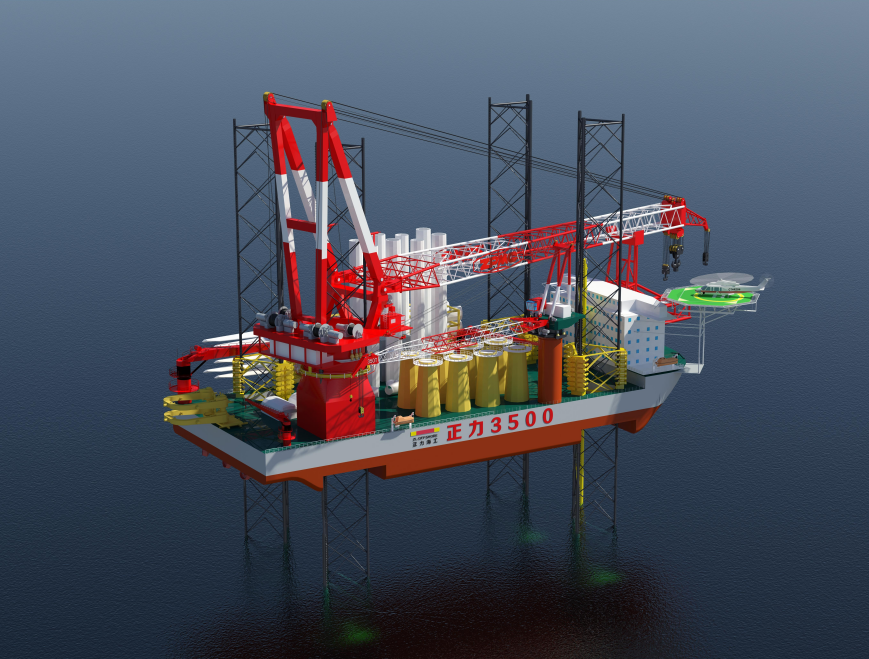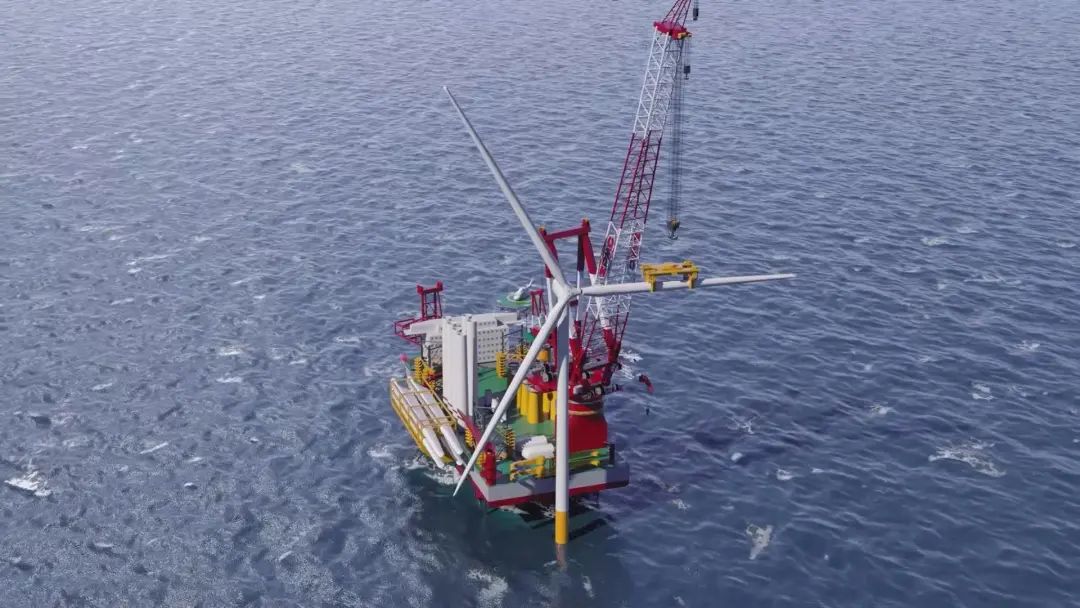The offshore wind power industry has added another "giant". Recently, the keel of a 3,500-ton self-propelled and self-elevating offshore wind installation platform was placed in Nantong. This platform, jointly built by Zhengli Haifa and Shanghai Zhenhua Heavy Industries, is the world's largest and most capable self-propelled and self-elevating offshore wind installation platform of its kind in terms of lifting capacity and comprehensive operational ability. It will become a powerful tool for China's new energy production and sustainable industry development.

Installing wind turbines with heights of over 100 meters and weights of thousands of tons onto the sea requires the use of specialized construction equipment, namely self-elevating wind turbine installation platforms. "The trend of larger wind turbines is a necessary measure for cost reduction and efficiency improvement as China's offshore wind power industry enters the era of parity pricing. The water depth of wind farms will also increase to over 50 meters, which prompts us to continue independently developing wind turbine installation platforms with greater lifting capacity and higher lifting heights," said Qiang Shifang, the chief engineer of the 3,500-ton self-propelled and self-elevating offshore wind installation platform project. Based on years of experience in providing integrated solutions for wind turbine platform hull design, cranes, lifting systems, DP dynamic positioning systems, and electrical control systems to the industry, the company has independently developed a 3,500-ton wind turbine installation platform capable of transporting, pile driving, and lifting 20-megawatt wind turbines, meeting the needs of offshore wind power construction operations in deep and remote waters.
The platform boasts many design highlights, with Qiang Shifang highlighting its core advantages as "greater lifting capacity, longer legs, faster hook lifting speeds, and strong forward-looking capabilities." The main crane adopts a dual-main-hook design, with the first main hook weighing 3,500 tons and the second main hook 1,200 tons. It can complete the self-turning of the 3,500-ton single-pile foundation without the need for additional auxiliary equipment such as pile turners. The auxiliary hook, with a capacity of 1,200 tons, is comparable to the main hook capacity of many current wind power platforms and can easily lift the nacelle of a 20-megawatt wind turbine using only the auxiliary hook. "The window period for offshore construction is very precious, and the lifting speed of the auxiliary hook is twice that of the main hook. Such a luxurious configuration can significantly improve the efficiency of wind turbine installation," said Qiang Shifang. Additionally, the platform's legs are 136 meters long, paired with a 280-square-meter pile shoe, breaking the previous record of 130 meters for the leg length of similar platforms. This allows it to adapt to the construction needs of wind farms in deep and remote waters with large water depths and soft geological conditions, making its application scenarios more extensive.
"The crane is the core component of the wind turbine installation platform, and all designs are aimed at serving the crane's lifting functions. This is the initial intention of our research and development," said Jiang Shuwei, the technical manager for detailed design of the project. To fully utilize the powerful performance of the crane, the research and development team adhered to the concept of "not only building the shell but also the core," achieving three major innovative research and development applications for the first time through special scientific research breakthroughs and design optimizations.
To meet the demand for greater lifting capacity, this project became the first wind turbine installation platform in China to adopt an 8-layer lifting mechanism. Guided by the market trend of low carbonization and facing the increase in the number of lifting mechanism layers, the research team adopted a differentiated design concept and innovatively arranged the platform's lifting mechanism. This was achieved by conducting a detailed analysis of the force characteristics of the pile legs and arranging different numbers and sets of lifting mechanisms for the four pile legs to achieve overall lightweight and low energy consumption. However, ensuring relatively uniform load bearing among the lifting mechanisms at each level during the lifting process became a new challenge. The research team leveraged their experience from previous truss-type pile leg projects, combined with the characteristics of wind turbine installation platforms, and independently developed new electronic control technology, which was repeatedly verified. "We applied new electronic control technology to the design of the gear and rack lifting system to ensure relatively uniform load bearing among the lifting mechanisms at each level, thereby improving the wear resistance and service life of the lifting gears," further explained Jiang Shuwei.
This platform will also be the first wind turbine installation platform in China to be equipped with a domestically developed DP-2 dynamic positioning control system. To make the platform more suitable for construction needs in harsh offshore conditions, Zhengli Haifa and Shanghai Zhenhua Heavy Industries broke through foreign.
Zhengli Marine Engineering Co., Ltd.
The address:30th Floor, Building 1 (Intelligent Industry
Building), Jinjing Bay Business Operation Center, Pingtan Comprehensive Experimental Zone, Fujian Province
Phone call:+86 591 8798837
Email address:zl@zloffshore.com
CopyRight © 2020 Zhengli Marine Engineering Co., Ltd. 闽ICP备17007219号 Technical Support: Baizhu Website